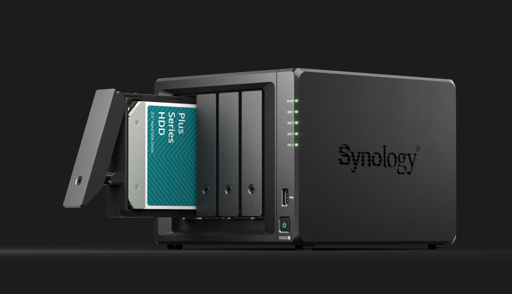Synology’s telegraphed moves toward a contained ecosystem and seemingly vertical integration are certain to rankle some of its biggest fans, who likely enjoy doing their own system building, shopping, and assembly for the perfect amount of storage. “Pro-sumers,” homelab enthusiasts, and those with just a lot of stuff to store at home, or in a small business, previously had a good reason to buy one Synology device every so many years, then stick into them whatever drives they happened to have or acquired at their desired prices. Synology’s stated needs for efficient support of drive arrays may be more defensible at the enterprise level, but as it gets closer to the home level, it suggests a different kind of optimization.
It’s like they don’t understand their demographic.
Yeah, I think their CEO might have QNAP stock or something.
It’s hilarious how dumb this is.
Hilarious and pathetic.
Like Brexit.
They absolutely do. But it’s a symptom of capitalism. They must seek higher and higher profits each year. And this is one of their ideas to seek higher profits…
Growth imperative. Greed will never be satiated.
The worst is that it will probably increase profit or a quarter or too while running the brand to the ground.
Actually perfect timing (for me, it’s all in all terrible)… I was about to buy myself a NAS and struggled to figure out which to get, and this removes at least one option.
As I read this, I am just transfering over to TrueNas on totally open hardware (from Synology). After 1 week, I am loving it. A bit of a learning curve, but TrueNas seems really nice and solid.
That would be my exit sign
Mine too. Already priced a new build half the price just the data migration I’m not looking forward too.
Curious as to what you are getting. Was planning to buy my Synology build some time later this year but not so sure about that anymore.
Building my own i3 8 bay build after finding a good cheap case called saggitarius on ali express
Can you migrate Synology data? I haven’t ever found a way.
Rsync or SCP?
Aren’t those for syncing data, not migrating data?
Same thing, no?
No, where am I supposed to sync the data to?
To the new system you’re migrating to
Another drive.
Edit: it’s the first line of the manpage: rsync – a fast, versatile, remote (and local) file-copying tool.
That’s a massive shot in the foot.
As a Synology owner, I already had enough - they have arbitrarily cut customer support to sanctioned jurisdictions, leaving me without the support they promised and I expected when paying for a device.
Next one will definitely be built from the ground up.
They are probably betting they will make more money from businesses. I.e., actual pros, vs prosumer.
I do like my Synology NAS I bought 10 yrs ago, but these days there are more and better alternatives for people who dont really need to pay for the support and stability.
I had Synology for a second but built my own server, went UnRAID, and never looked back.
Started messing around with docker containers on a small Synology box a few years ago, dumped Synology with a quickness in favor of just building an Ubuntu-based NAS. I’m running TrueNAS Scale bare metal now and getting ready to dump it to go back to another roll-my-own Linux + ZFS setup, possibly using Cockpit and the ZFS extensions from 45 drives.
This is the way.
Damn it I already own own one. I guess I funded this cunt corporate move
Me too. Invested in my setup last year :(
Yeah I expected that this would happen. They already did this with RAM. They just rebrand RAM, sell it for a way higher price and add a check. When they brought their own branded HDDs, I knew they will pull of the same scam.
Building an own server isn’t that more expensive and you don’t have to deal with the whole lockout with Synology. For example I had quite the issue to access hardware. I wasn’t able to get Home Assistant running on my NAS. The issue was my Zigbee USB Stick. I got it running to the point where I was able to send commands (e.g. turn on or off lights) but the status didn’t came back. I threw it on my Pi3 (now Pi5) and zero issues.
The next NAS is self build. Probably Proxmox as base, with truenas or so as main server and the rest depends on what I might need.
Such a silly move. Like shooting yourself in the foot to sell more bullets
I have a synology I bought 3rd party ram (not synology) and it works fine. Same with drives just bought some seagate drives. Probably going to upgrade from a 4 bay to a 12 and I don’t see compatibility of ram being an issue. I just don’t feel like building a whole racked system I just want to plug and play and forget. As of now tho only thing I lose is warranty cause I’m using not “certified” ram and drives.
The enshittification/rent seeking continues. Nothing is sacred.
If I had known how bad it’d get I would’ve chosen a different field to work in. Sure, I can avoid it in my private life but on the job it’s like I’m in some kind of hostage situation.
“Oh hi there customer! You know our product your users are accustomed to will only come as a subscription from now on and it’ll also be really bad and force full screen ads. We’ll push two updates per day because our unpaid interns are so agile. Bugs? Oh, no, we call those ‘micro disruptions’. They’re a feature but don’t cost extra! How much the license costs? Well, how much do you have? Yes, it’ll be that much.”
Synology is like Ubiquity in the self-hosted community: sure it’s self-hosted, but it’s definitely not yours. End of the day you get to deal with their decisions.
Terramaster lets you run your own OS on their machine. That’s basically what a homelabber wants: a good chassis and components. I couldn’t see a reason to buy a Synology after Terramaster and Ugreen started ramping out their product lines which let you run whatever OS you wanted. Synology at this point is for people who either don’t know what they’re doing or want to remain hands-off with storage management (which is valid; you don’t want to do more work when you get home for work). Unfortunately, such customers are now out in the lurch, so TrueNAS or trust some other company to hold your data safe.
Lol! Not like uGreen put any roadblocks to running your own OS (like disabling the watch dog feature in the BIOS and some other setting to enable custom boot).
And you don’t have any fan control on their NAS. Either you estimate and configure correcrly or you need to schedule downtime.
Actual servers let you live tune (some of) the power settings. Synology supports changing the fan profile in the live OS.Damn I was really happy for ugreen, terrormaster it is then.
It’s not like you can’t do it (I did save the original SSD and replaced it with a new one and installed TrueNas Scale). It’s just not intended to do from uGreens perspective.
Edit: I think I used either of these guides I used on how to open and how to install the new OS:
https://youtu.be/BWNH_JzMNPc
https://youtu.be/R8t-Wqx_E3U
https://youtu.be/yh8Ao5ryOeEOh yeah. The HDD indicator bays are partly non-functional as well.
But you can restore some functionality with scripts you run periodically with cron. Juat search “ugreen dxp4800plus led cli github” to find it.Edit2:
And I only chose a uGreen NAS due to the Kickstarter price. Because that was a 40% price reduction.
At least I got a solid Model that is really nice. It also has a magnetic metal dust cover Ican easily remove if needed (even easier than the one on my pc case front panel which is a Fractal Design North)
I own a Synology NAS. It’ll be the first and last one I buy. When I need an upgrade I’ll go back to building my own again.
I was thinking of buying a Synology system. I was actually looking at prices this past week.
That being said, I’ve got an old 2019 desktop running Windows that is coming to the end of its support, that I was considering making a Linux machine.
How complex is making a roll-your-own NAS?
How complex is making a roll-your-own NAS?
It really depends on what you want out of it. I personally installed ProxMox on an old gaming machine (DDR3 RAM old lol) and have an Open Media Vault virtual machine running on it with access to my ZFS mirrored pair of storage drives.
Enabling Samba support in Open Media Vault gives you a nice little NAS. I believe it’s okay to install bare metal if you really want to also.
It also has a nice Docker interface, so although I should probably not bundle services together so tightly, it runs things like Jellyfin for media, Paperless NGX for document storage, and NextCloud AIO for a convenient (if slightly resource-hungry) interface.
ProxMox lets me do fun things though, like back up the VMs, spin up virtual machines for PiHole ad blocking and Klipper for controlling my 3D printer.
My most important data gets synced to a subscription to a service called iDrive as my offsite. Pretty affordable for 5TB and my own encryption keys. :)
I want to stress that I’m not an IT professional or anything either. If you’re reasonably comfortable with Linux and understand some basic networking, I’d say at least getting Proxmox and/or Open Media Vault up and running so you can access it on your home network isn’t too hard.
Outside of that, and if you want HTTPS and stuff? There’s lots of guides but I would recommend using TailScale instead of opening any ports to the web.
Sorry if this post was meandering but hope it gave you a little bit to go on! :)
Really depends on what you want out of the system, what you can spend and how much time you want to spend on it.
My old z390 itx system has a 16x PCIE to 4x m.2 card - leveraging an m.2 to 5x SATA adaptor with the built in SATA adaptors has given it plenty of space.
Considering I can grab m.2 to 6 SATA adaptors and fill the remainder of the slots that’s a decent chunk of drives from a single PCIE x16 slot.
Software is another kettle of fish and a good way to timesink, I’d rather not give too much of my personal experience as there are so many ways to skin that cat.
I have mini-ITX board in a mini case. 4 bays, 16 GB RAM of DDR3-L and a slow but very low TDP CPU. This thing is very low power but it’s on 24/7.
Runs home assistant with zigbee, rtl433 and whatever it detects over the network. A few older game servers (minecraft, minetest/luanti, quake 2), miniDLNA, … Arch Linux, so rolling release and always up to date with the latest versions.
Served me greatly and I haven’t upgraded because it still does what I want and I can’t find any modern CPU with a TDP this low.
It’s not too complicated but you don’t get some things for free like with Synology. It require work to setup scripts for offsite backup for example whereas Synology has a backup app with a UI.
For storage, I used to run ZFS in a raidZ2 configuration. If you do this then I suggest having a cron job running a script that can alert you if the pool is unhealthy. This is again something that Synology does for free.
You could also look up trueNAS core and see if that’s something that fits for you.
I’ve heard good things about Qnap
but I also heard good things about Synology…
Also on my first and last I think.
Well, I had been considering one, but I guess not
It sucks, because all things considered, they’re great little devices. I really like mine.
That’s what I’ve heard… Getting real tired of people building great products only for corpos to find a way to make it terrible for an extra buck
I get why they do this sort of thing but it didn’t stop us re-adding video station and h265 support back into our Synos.
Someone already made a script to overwrite the existing compatible drive checker so someone will write a new script to fix the new one.
Oh, snap, bringing me the magic I need, but didn’t know to look for.
I’ve been refusing to update because of video station. Looks like I’m saving your comment for later.
The real shame is they didn’t open source the app on decom.
I remember arguing with some nerd that this overpriced shit was not fucking worth it and my build based on old server parts I got from a local computer recycler was infinitely superior in every way
I wish I saved that post so I could reply with this link. I feel so validated. Never trust companies. It’s why I say you should never fuck with plex, even if it is a bit easier to deploy than Jellyfin.
Yeah… Never had a specific “server” certified hardware and always repurpose my hold hardware stuff. Never failed me !!
However, there are some functions specific to NAS’ like low power and other stuff people mention but I already forgot.
IMO all this NAS and certified server stuff is good for Enterprise shit and the like… But for homelabbing it’s probably overkill and way to much overpriced for the little gain…
Except maybe for the ease of use and plug and play function? Each one it’s own I guess !
There’s plenty of N100/N350 motherboards with 6 SATA ports on AliExpress, grab them while you can
Do you happen to know about a decent solution for 8 SATA ports on a mini-ITX board?
Yes,
https://www.silverstonetek.com/en/product/info/expansion-cards/ECS07/ https://www.amazon.com/Adapter-RIITOP-Expansion-Chipset-ASM1166/dp/B0D8BCWHPT
https://www.aliexpress.com/item/1005003335714128.html
Then you have 4 main plus these 5-6 extra. Just put your boot drive on a data drive instead of m.2 or get an adaptor and you are good to go. 8 data drives plus a boot drive
Thank you. I have seen the ASM1166 mentioned before as part of such a solution, but the other suggestions were new to me.
Can you also confirm to me, have I got it right that (some/all? of) the N100 boards has everything included regarding CPU, GPU and RAM, while most other mini-ITX boards come without those? Or did I get that wrong? Sorry for bothering you, but it’s all still a bit confusing to me, and I have an empty Jonsbo N3 case, and some 22TB drives that are longing to move into their house.
The only reason I even have “server” parts is because they were dirt cheap at the recycling center. Before I used this my rig was an old pc from a doctors office I worked at they were going to throw away from like 2009. It was awful spec wise but it did the job. My current build is overkill but I wanted to play with vms and local LLM stuff and the hardware was cheap, so why not?
low power is definitely something to consider though. That said there are some people that have made impressive builds out there. There are some low power builds on the unraid forums that use even less power than one of these things. It’s a bit more up front because it relies on some niche hardware but the power usage is so low it’s maybe worthwhile if you use it for years
I just fail to see the benefit of these. Ease of use for sure but assembling a pc is really not difficult and installing an OS is not hard either. And an os like unraid or truenas is pretty simple to use, they hold your hand a lot. Like I get that running Debian is something not everyone wants to do but then it’s like, just don’t do that then?
Frankly if you’re capable enough to configure the dockers you’d run on one of these, like plex or Jellyfin, I would think you could handle those things??
Oh yeah sorry ! For the ease of use part I ment the NAS stuff which already comes bundled with all the necessary software to keep things easy but less customizable !
Yeah if you get IT enterprise hardware for free it’s kinda similar to repurposing, sooo that’s a great deal and lucky you !!!
But I would never put 1$ myself into specific server stuff ! Except if one day I want to contribute to the self-hosted/opensource community and host something like newpipe that needs to be publicly available.Then yeah, proper hardware and software stuff is mandatory !
Sorry if my comment came by rude, that wasn’t my purpose !
No need to be sorry, I did not take it that way, we are best friends forever. More to clarify that there are a ton of old server parts out there for dirt cheap if you’re okay with saving e waste from the trash heap.
You are absolutely right that homelabs are totally fine on consumer grade hardware but check server parts too, you might be surprised at the deals you find, especially locally. My build was a 10th gen intel build and cpu/mobo/32gb ecc ram/heatsink missing fan was $125. That was several years ago though and now we got tarrrrriiifffsss













